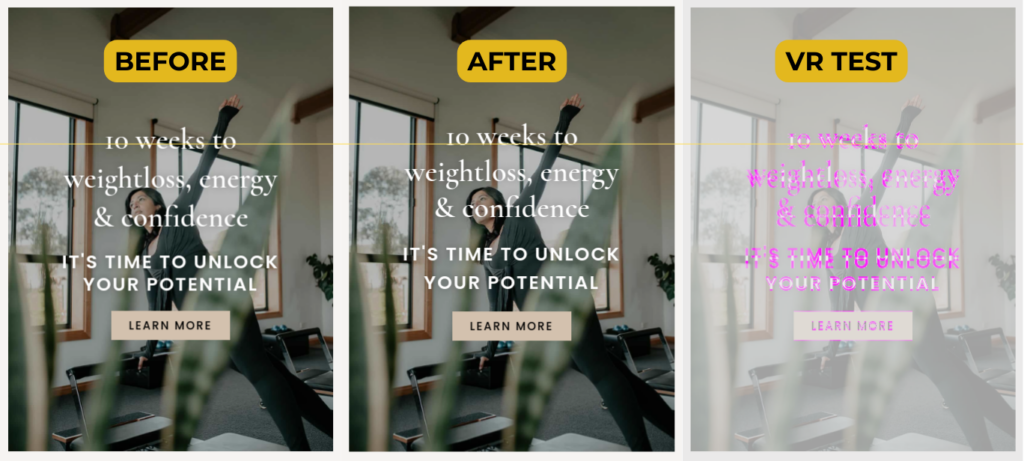A Little to the Left: What Would You Do if Your Site Design is Microscopically Different?
Spending hours maintaining client sites?
WP Remote will streamline your WordPress maintenance process and save you at least 4 hours every week.

We spend a lot of energy getting site design right. And with good reason! Because gone are the days where a bad-looking site with good content (and great intentions) will convert.
We spend still more energy carefully maintaining site design too. It needs to work just so every time.
Therefore, when updating a site, the biggest fear is that the site will crash. Or perhaps there will be a break in the design. A form that goes askew, a button that stops working, or even analytics that vanishes without so much as a squeak.
We are hardwired to check for these huge problems, and therefore we have built guardrails. Borrowing from the lexicon of developers, marketers have learned to test updates on staging, take backups, and heed uptime monitoring alerts.
Then an issue comes along that gets under your skin.
What happened?
A few weeks ago, a very popular theme released an update. Thousands of site owners applied the update after thoroughly checking it on their staging sites, and seeing that all the elements were in place.
Or at least they seemed to be.
As it turned out, the theme update moved a lot of page elements slightly. Very slightly, in fact. In some cases, we are talking about 1px to the bottom. Logos, images, menus, headers, paragraphs, etc. All 1px off.

But everything looks right?
Honestly, the last thing you would expect from a theme update is a change in your site design—especially if you’ve meticulously tested it beforehand.
Or at least, if there is a change, it would be glaringly, obviously visible.
But a 1px change is not visible to the human eye; not even when everything on the page is off by 1px. Perhaps it is invisible to a human because everything is off, but proportionately still in place.
It was, however, very visible to our visual monitoring tool.
Visual monitoring compares a before and after screenshot of important pages during updates. It can be set to a 1% sensitivity, and is intended to catch issues like broken elements or changes in design, so they can be fixed quickly.
So, as you can imagine, the 1px change in pages across thousands of sites sent tens of thousands of visual regression alerts after the theme was updated.
Is it a big deal though?
One could argue that a 1px difference is negligible. In the majority of cases, nothing was broken. Does it really matter if a logo is 1px to the bottom/right/left of where it should be?
Perhaps not. Realistically not. There is no change in user experience at all. Most users and—let’s be honest—designers can’t tell the difference.
But it is annoying. Getting an alert that there is a change in your site design that you can’t see is an unsettling experience.
After the initial flurry, everything settled right back down. Life went on.
Takeaways
The takeaway here is that theme updates change sites. Sometimes the changes are visible; others they are not. Over time though, the differences can add up and have a cascading effect.
Imagine investing resources into building the perfect design, and necessary updates degrade it over time. Not to be dramatic, but it is like death by a thousand cuts.
So, while no one lost any sleep over the 1px difference, it was still annoying to realise that you’ve lost control. The worst case scenario is that you’ve eventually relinquished your site design.
And without visual regression testing? You wouldn’t have been any the wiser.
Tags:
Share it:
You may also like

Introducing WP Remote’s Page Content Monitoring: Ensuring Complete Website Functionality
Ensuring your website is accessible is crucial, but it’s only part of the picture when it comes to full site functionality. Even when your site appears up, critical components such…

Never Miss A Domain Renewal Again: Introducing WP Remote’s Domain Monitoring
Domain renewals are another line item in a long list of things to remember. Especially if you have purchased domains for longer terms—think three- and five-year licenses—it is all too…

WP Remote’s Revamped Auto-Update Feature and Notifications
Managing updates on WordPress sites has always been crucial. Each plugin, theme, or core update requires attention to ensure compatibility and security. However, it’s traditionally been quite a task for…
How do you manage your websites?
Managing multiple WordPress websites can be time consuming and error-prone. WP Remote will save you hours every day while providing you complete peace of mind.

Managing everything yourself
But it’s too time-consuming, complicated and stops you from achieving your full potential. You don’t want to put your clients’ sites at risk with inefficient management.

Putting together multiple tools
But these tools don’t work together seamlessly and end up costing you a lot more time and money.


